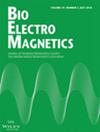Kassra Ghassemkhani, Blake T. Dotta
下载PDF
{"title":"θ脉冲电磁场会干扰涡虫的学习吗?恐惧条件反应受损的证据","authors":"Kassra Ghassemkhani, Blake T. Dotta","doi":"10.1002/bem.70017","DOIUrl":null,"url":null,"abstract":"<p>This study explored the impact of low-intensity theta burst patterned electromagnetic fields (TBEMF) on fear-related learning in the flatworm species Planaria, a simple model organism known for its regenerative properties and ability to demonstrate basic learning behaviors. Planaria were exposed to an aversive stimulus (light) in a T-maze, and changes in their behavior, including time taken to select an arm and preferred arm selections, were assessed over the course of several days. The TBEMF consisted of five pulsed bursts at 100 Hz with alternating amplitudes and an intensity of 1 μT. In the group exposed to aversive light, a significant decrease in preferred arm selections was observed (<i>p</i> < 0.001), indicating that the planaria successfully learned to avoid the arm associated with the aversive stimulus. However, planaria exposed to TBEMF, either before or after the light exposure phase, did not show the same behavioral adaptation, as their arm selections remained stable, indicating that no fear learning occurred. These findings suggest that TBEMF disrupts the processes involved in fear-related learning, likely by interfering with theta rhythm-dependent mechanisms that are crucial for memory encoding and retrieval. Further exploration of EMF's effects on more complex organisms could reveal additional insights into its broader applications and implications for both basic neuroscience and clinical practice. Bioelectromagnetics. 00:00–00, 2025. © 2025 Bioelectromagnetics Society.</p>","PeriodicalId":8956,"journal":{"name":"Bioelectromagnetics","volume":"46 6","pages":""},"PeriodicalIF":1.2000,"publicationDate":"2025-07-31","publicationTypes":"Journal Article","fieldsOfStudy":null,"isOpenAccess":false,"openAccessPdf":"https://onlinelibrary.wiley.com/doi/epdf/10.1002/bem.70017","citationCount":"0","resultStr":"{\"title\":\"Can Theta Burst Electromagnetic Fields Disrupt Learning in Planaria? Evidence of Impaired Fear-Conditioned Responses\",\"authors\":\"Kassra Ghassemkhani, Blake T. Dotta\",\"doi\":\"10.1002/bem.70017\",\"DOIUrl\":null,\"url\":null,\"abstract\":\"<p>This study explored the impact of low-intensity theta burst patterned electromagnetic fields (TBEMF) on fear-related learning in the flatworm species Planaria, a simple model organism known for its regenerative properties and ability to demonstrate basic learning behaviors. Planaria were exposed to an aversive stimulus (light) in a T-maze, and changes in their behavior, including time taken to select an arm and preferred arm selections, were assessed over the course of several days. The TBEMF consisted of five pulsed bursts at 100 Hz with alternating amplitudes and an intensity of 1 μT. In the group exposed to aversive light, a significant decrease in preferred arm selections was observed (<i>p</i> < 0.001), indicating that the planaria successfully learned to avoid the arm associated with the aversive stimulus. However, planaria exposed to TBEMF, either before or after the light exposure phase, did not show the same behavioral adaptation, as their arm selections remained stable, indicating that no fear learning occurred. These findings suggest that TBEMF disrupts the processes involved in fear-related learning, likely by interfering with theta rhythm-dependent mechanisms that are crucial for memory encoding and retrieval. Further exploration of EMF's effects on more complex organisms could reveal additional insights into its broader applications and implications for both basic neuroscience and clinical practice. Bioelectromagnetics. 00:00–00, 2025. © 2025 Bioelectromagnetics Society.</p>\",\"PeriodicalId\":8956,\"journal\":{\"name\":\"Bioelectromagnetics\",\"volume\":\"46 6\",\"pages\":\"\"},\"PeriodicalIF\":1.2000,\"publicationDate\":\"2025-07-31\",\"publicationTypes\":\"Journal Article\",\"fieldsOfStudy\":null,\"isOpenAccess\":false,\"openAccessPdf\":\"https://onlinelibrary.wiley.com/doi/epdf/10.1002/bem.70017\",\"citationCount\":\"0\",\"resultStr\":null,\"platform\":\"Semanticscholar\",\"paperid\":null,\"PeriodicalName\":\"Bioelectromagnetics\",\"FirstCategoryId\":\"99\",\"ListUrlMain\":\"https://onlinelibrary.wiley.com/doi/10.1002/bem.70017\",\"RegionNum\":3,\"RegionCategory\":\"生物学\",\"ArticlePicture\":[],\"TitleCN\":null,\"AbstractTextCN\":null,\"PMCID\":null,\"EPubDate\":\"\",\"PubModel\":\"\",\"JCR\":\"Q3\",\"JCRName\":\"BIOLOGY\",\"Score\":null,\"Total\":0}","platform":"Semanticscholar","paperid":null,"PeriodicalName":"Bioelectromagnetics","FirstCategoryId":"99","ListUrlMain":"https://onlinelibrary.wiley.com/doi/10.1002/bem.70017","RegionNum":3,"RegionCategory":"生物学","ArticlePicture":[],"TitleCN":null,"AbstractTextCN":null,"PMCID":null,"EPubDate":"","PubModel":"","JCR":"Q3","JCRName":"BIOLOGY","Score":null,"Total":0}
引用次数: 0
引用
批量引用


 求助内容:
求助内容: 应助结果提醒方式:
应助结果提醒方式:


